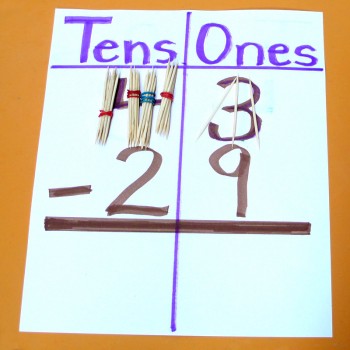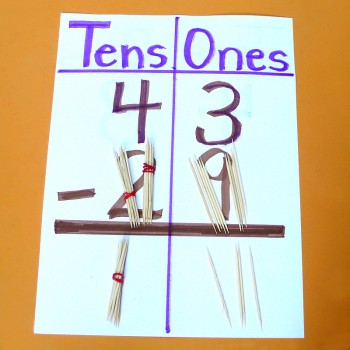Lesson Plans for Elementary School Students
Full Length Lesson Plans from an Elementary School Teacher
Math Lesson Plan: Popsicle Stick Regrouping Fun

Objectives:
- Learning and practising regrouping
- Print examples of regrouping in student math journals
- Learn term names: minuend take away subtrahend equals difference/answer (for subtraction) and addend plus addend equals sum/answer (for addition)
Materials for each group of 4-6 students:
- twenty groups of 10 popsicle sticks or toothpicks gathered with an elastic, plus 10-20 loose popsicle sticks (students can count out sets of 10 on their desks and you can help them wrap the elastics around them)
- index cards with numerals 0-9 on them, one number on each card, as well as cards printed with “+” , “-“, “Ones”, “Tens”, and “Hundreds”, PLUS SOME BLANK INDEX CARDS (for the answers).
- math journals for each student
- pencils and erasers for each student
- Chalkboard or Chartboard showing an example of one addition question plus one subtraction question, heading up the columns with “Hundreds”, “Tens” and “Ones”. The title above the two questions says “Regrouping”.
- Marker for each group (to write the numerals needed for the answer cards)

- Each group of students finds an area to sit in a group, either in a gathering of their 4-6 desks or on the floor somewhere. Teacher gives each group ten numeral cards 0-9, plus cards with “+”, “-“, “Ones”, “Tens” and “Hundreds”, plus some blank index cards. Also give twenty bunches of 10 popsicle sticks gathered with elastics, plus 10-20 loose popsicle sticks. They each have their pencils and erasers and math journals with them.
- Teacher tells students, “We are going to practise regrouping. First we’ll ‘make’ the number with the cards, then we’ll ‘make’ the number with the popsicle sticks. We’ll learn how to ‘regroup’ the digits so that we can add or subtract the numbers really easily.”(Teacher info: I mix the grades in the groups, so that all groups comprise of both grades; the grade 2’s LOVE to help the grade 1’s master this. Grade 1’s just have to add or subtract to 100, Grade 2’s up to 200.)
- Teacher then calls all students together in a learning circle and tells them that we’re going to do the first few questions together. Work with the students as a group for a few minutes until they ‘get’ the idea.
- Put down a card that says “Ones”. Tell students that only numbers with one digit can go under this card. Have them tell you all the numbers with one digit (1, 2, 3, 4, 5, 6, 7, 8, 9). Tell students that therefore only up to 9 popsicle sticks can STAY** under this column. Once you have 10 popsicle sticks, you need to regroup them into a group of 10 with an elastic around them and move them into another group.
- Put down the “Tens” card to the left of the “Ones” card. Tell students that only up to 9 groups of ten popsicle sticks can STAY** there (**This is important because when you regroup later you will have to add 10 to a number in the Ones column so you may have 13 popsicle sticks in the Ones column for a minute or too**). Once you get 10 groups of 10 popsicle sticks, (100, count by 10’s so they see that it’s 100) they have to go into a new column “Hundreds”. Put that card to the left of the “Tens”.
- Ask a student to give you a two digit number (43). Teacher puts down the card 4, then the card 3. Ask for another number (21). Teacher puts down the card 2, then the card 1. Line them up above each other, in tens and ones and hundreds columns. Put the card “+” in front of the 21.
- Get students to help you put the correct number of popsicle sticks on each number card. Example: 3 popsicle sticks go on the “3” card. 4 groups of 10 popsicle sticks go on the “4” card EQUALING 43. Ask students what number this makes. Have them count the popsicle sticks to make sure it’s correct…10, 20, 30, 40, 41, 42, 43.
- Do the same for 21….10, 20, 21. Popsicle sticks sit on top of each numeral card. Example 2 groups of 10 sit on the 2 and 1 single popsicle stick sits on the 1 card.
- Now tell students we’re going to ADD 43 and 21. Put down two blank index cards where the answer will go and tell students this is the answer. We don’t know it yet. It’s blank or unknown. Tell them we always start with the ones. 3 ones and 1 one is 4 ones, so gather up the 1 and the 3 and put the 4 popsicle sticks on the blank card in the “Ones” column. Now have them help you ‘add’ the 4 groups of 10 (40) and the 2 groups of 10 (20), counting by 10’s….so they get the answer 6 groups. Put the 6 groups on the card in the “Tens” column. Ask them what the answer is. See if they can count by 10’s and add the 1’s to get 64. When they ‘get’ the answer, print the numerals on each card “6” and “4”. Show them how to print the question and answer in their math journals.I’ve done this with quite a few grade 1 and 2 mixed classes. They always ‘get’ it and it’s super for getting them to understand that the ‘4’ in ’40’ is really ‘4 groups of 10’ and when you get ‘100’, it’s really 1 group of 10 bunches of 10’s.This lesson is a great one to do before you start working with the hundreds flats.After they understand the regrouping concept, you can do this same lesson with unit cubes (1’s), ten rods (10’s) and hundred flats (100), switching 10 single unit cubes for the ten rods and switching the ten rods for the hundreds flats when you regroup. It makes regrouping so easy to understand when you see it done like this.
- Do a subtraction question with them before you send them into their groups to work. Try 51 – 29 Have students put the 5 groups of 10 on the “5”, the 1 single on the “1”, the 2 groups of 10 on the “2” and the 9 singles on the “9. Ask them if they can take 9 away from the 1. No, of course not. Tell them that you need to “regroup” the popsicle sticks so that you can take away the 9. Take one of the group from the numeral “5” , undo the elastic and put the 10 popsicle sticks with the 1 so you now have 11. Can we take 9 from 11 now? Yes. Put the “2” in the “Ones” column on the blank answer card. Now we have 40 take away 20. Have them count the 4 groups and 2 groups of 10, so you take away 2 groups from 4 groups and you get 2 groups. Put the 2 groups of 10 on the “Tens” answer card. Have them count the answer and tell you what the numerals will be “2” and “2”. Print the answer on the blank answer cards. On the whiteboard, show them how you cross off the “51” and write ‘4 and 11’ above it so students can see you “regrouped” the “51” into ‘4 groups of 10 and 11′ which still add up to ’51’. They can see how they got ‘2’ when they took away the 9 from the 11, and then they can see how they got ‘2 groups of 10’ when they took ‘2 groups of 10’ away from the ‘4 groups of 10’ which was regrouped into ‘4 groups of 10 and 11’.
- Have students go back to their groups and either have them do a few questions you write on the chalkboard or chartboard, or call them out one at a time, orally, then taking up each question before giving out a new one. Students now explain to you how they got the answer, explaining how they regrouped their popsicle sticks to you.
- I start out with adding questions, then go to subtraction questions, keeping them simple for a bit, until I see that they understand the concept of regrouping. Then I begin alternating the questions for grades 1 and 2. For example, I’ll say, “This is a grade 1 question.” The grade 1’s control the cards and the regrouping efforts. Grade 2’s can help. Then “This is a grade 2 question.” The grade 2’s are in charge now and work on the “harder” questions but the grade 1’s can help them still. I have found that they grasp this concept so well, often the grade 1’s can do the harder grade 2 questions (questions over 200) just as easily as the grade 2’s.
- You can show students how to double check their answers for subtraction by adding the subtrahend and the difference (for subtraction). The popsicle sticks are still on the subtrahend and the difference (or answer) (for subtraction). You can also teach them the names of the numbers for addition: add one addend to the other addend to get the sum (answer).
Tags: addend, adding, difference, hundreds flat, minuend, regrouping, subtracting, subtrahend, sum, ten rods, unit cubes

Will be trying this with my granddaughter.